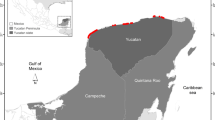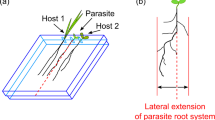Summary
Rhinanthus minor (Yellow-rattle) is a widespread hemiparasitic plant of grassland habitats throughout Britain. Association analysis of the dune vegetation at Holme-next-the-Sea in eastern England revealed only two potential host plants through positive association. In contrast direct examination of the root systems revealed haustorial connections with 20 host species. The number of species parasitized by one plant ranged from one to seven. Data from another four sites in Britain and one in central Europe indicate that the natural host range of R. minor encompasses at least 50 species from 18 families with 22% in the Leguminosae and 30% in the Gramineae. Comparison of the number of haustorial connections made to each species with the abundance of roots in the soil shows that R. minor is a highly selective parasite, but that the selectivity is not consistent between populations or between plants from different parts of the same population. The reasons for host selectivity are discussed.
Similar content being viewed by others
References
Atsatt PR, Strong DR (1970) The population biology of annual grassland hemiparasites. I. The host environment. Evolution 24:278–291
Cantlon JE, Curtis EJC, Malcolm WM (1963) Studies of Melampyrum lineare. Ecology 44:466–474
Chuang T, Heckard LR (1971) Observations on root parasitism in Cordylanthus (Scrophulariaceae). Am J Bot 58:218–228
Crosby-Browne AJ (1950) The root parasitism of Euphrasia salisburgensis Funck. Watsonia 1:354–355
De Hullu E (1985) Population Dynamics of Rhinanthus angustifolius in a Succession Series. PhD thesis, University of Groningen
Fresco L (1980) Ecological response curves of Rhinanthus serotinus, a synecological study. Acta Bot Neerl 29:533–539
Hodgson JF (1973) Aspects of the Carbon Nutrition of Angiospermous Parasites. PhD thesis, University of Sheffield
Kuijt J (1969) The Biology of Parasitic Flowering Plants. University of California Press, Berkeley
Malcolm WM (1966) Root parasitism of Castilleja coccinea. Ecology 47:179–186
Musselman LJ, Mann WF (1977) Host plants of some Rhinanthoideae (Scrophulariaceae) of eastern North America. Plant Syst Evol 127:45–53
Piehl MA (1962a) The parasitic behaviour of Dasistoma macrophylla. Rhodora 64:331–336
Piehl MA (1962b) The parasitic behaviour of Melampyrum lineare and a note on its seed colour. Rhodora 64:15–22
Pichl MA (1963) Mode of attachment, haustorium structure and hosts of Pedicularis canadensis. Am J Bot 50:978–985
Ranwell DS (1972) Ecology of Salt Marshes and Sand Dunes. Chapman and Hall, London
Smith AJE (1963) Variation in Melampyrum pratense. Watsonia 5:336–367
Sprague EF (1962) Parasitism in Pedicularis. Madroño 16:192–200
Watkinson AR, Gibson CC (1988) Plant parasitism: the population dynamics of parasitic plants and their effects upon plant community structure. In: Davy AJ, Hutchings MJ, Watkinson AR (eds) Plant Population Ecology. Blackwell Scientific Publications, Oxford, pp 393–411
Weber HC (1976a) Über Wirtspflanzen und Parasitismus einiger mitteleuropäischer Rhinanthoideae (Scrophulariaceae). Plant Syst Evol 125:97–107
Weber HC (1976b) Studies on new types of haustoria in some central European Rhinanthoideae (Scrophulariaceae). Plant Syst Evol 125:223–232
Weber HC, Weberling F (1975) Zur Morphologie der Haustorien von Rhinanthoideen (Scroph.) Ber Deutsch Bot Ges 88:329–345
Author information
Authors and Affiliations
Rights and permissions
About this article
Cite this article
Gibson, C.C., Watkinson, A.R. The host range and selectivity of a parasitic plant: Rhinanthus minor L.. Oecologia 78, 401–406 (1989). https://doi.org/10.1007/BF00379116
Received:
Issue Date:
DOI: https://doi.org/10.1007/BF00379116




